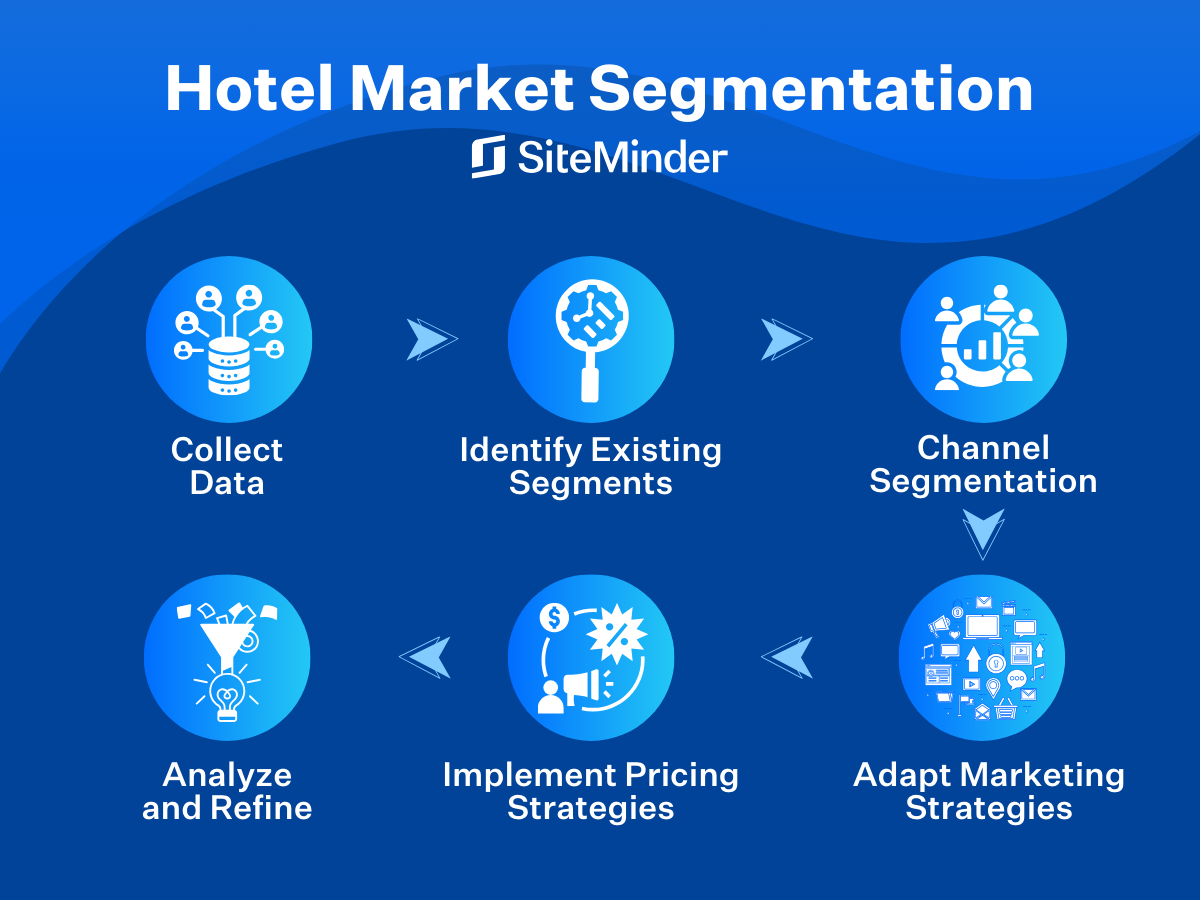What is hotel market segmentation?
Hotel market segmentation is a strategy used to identify key customer segments in a hotel. Hotel market segments rely on guest data and offer a structured view, with an opportunity to slice and look at the data in different ways. When used appropriately, it empowers decision-makers in hotels to target specific market segments with individual strategies, from marketing to pricing.
What is psychographic segmentation in the hotel industry?
Psychographic segmentation in the hotel industry is all about understanding your guests on a deeper level. Instead of just looking at details like age or income, you focus on their lifestyle, values, interests, and personality traits. This helps you tailor your marketing and services to align with what truly matters to them, in addition with their demographic, geographic, behavioural, and technographic traits.
For instance, you might attract eco-conscious travellers by highlighting your sustainable practices, or appeal to luxury seekers by offering exclusive experiences. By tapping into what drives your guests, you can create more personalised experiences, leading to higher satisfaction and stronger loyalty.
Table of contents
Why is market segmentation important for your hotel?
Segmenting the guests that come to stay at your hotel will help both your business and your customers. On the business front, it lets you identify who the most common groups are that are booking with you and outlines which groups you might want to target more thoroughly. It will also inform your marketing strategies, making it easier to acquire those valuable guests that you’re chasing.
Hotels collect a lot of guest information during the booking process and stay. While not all the information is consistent across all channels (for example, direct reservations may carry fields of data OTAs do not provide), making sense of consistent data components is required to successfully understand your own hotel’s market segmentation. It is a crucial step in applying this data for the benefit of the hotel’s business.
For example, when you identify the market segment that offers your hotel the longest stays you can focus on this segment to drive up the average length of stay in your property. This may be a goal if reducing housekeeping costs for turning over rooms is on your agenda.
Maximise revenue from your ideal guest segments easier with SiteMinder Access powerful and insightful data and performance reports with our leading hotel platform.
Benefits of hotel market segmentation
Segmenting and profiling your hotel guests is a powerful strategy that allows you to understand who your customers truly are and what they need. By breaking down your guest base into distinct groups based on their preferences, behaviours, and demographics, you can create more personalised experiences, optimise your marketing efforts, and ultimately drive better business outcomes. Here’s how leveraging this approach can lead to tangible benefits for your hotel, from enhanced guest satisfaction to improved financial performance.
Here’s a list of the benefits of segmenting and profiling your hotel guests:
- Understanding customer needs means you can implement more attractive packages and up-sell offers
- Understanding customer needs means you can deliver better service
- Delivering better service increases positive reviews and encourages word of mouth marketing
- Knowing your customer enables you make better decisions and adapt quicker when required
- You’ll have more insights into which booking channels to prioritise, improve, or remove
- Forecasting, budgeting, and selling is made much easier
- Hotel performance is boosted with increases in occupancy and revenue expected once you are using strategies based on guest data
An additional step is understanding the market segmentation of your local market: knowing what travellers are already staying in your market sets the tone for establishing fair share and fuels meaningful comparisons as well as realistic outlooks.
For guests, it will mean a more personalised offering and service that responds directly to their preferences before and during their stay. When they feel like they’re being hosted by someone who knows them and will deliver what they need, the motivation to spend is higher. Oh, that’s another benefit to your business.

Hotel market segments examples
There are no rules as to how you choose to segment the market for your hotel in your individual analysis, however there are recurring themes across hotel data providers and revenue tools that are useful to understand.
- STR: The global supplier of weekly benchmarking data to the different market segments in the hotel industry also provides insights divided into three segments. Transient (including most retail, discounted and negotiated rates), group and contracted business are separated by their reporting guidelines.
- Revenue tools: Depending on individual setups, most revenue tools use rate categories from your PMS to group reservations into hotel target market segments including group, retail, discount, negotiated, wholesale and other. They may also group by channel to provide segmentation.
Based on the information you collect you can create personas that represent your current guest segments and even new segments you want to focus on. Give them your own nicknames or use pre-defined groups that match what you’re seeing at your hotel.
Some examples you might commonly see and are featured in our workbook in more detail include:
- Adventurers
- Luxury lovers
- Social influencers/influenced
- Families
- Generation zen
- Socially/Politically conscious
- Wellness travellers
- Digital nomads
- Baby boomers
- Business professionals
- Solo travellers
Even within some of these broad segments there are subsections you can drill down on. For instance, instead of solo travellers – female solo travellers. Getting more specific lets you target even better and deliver even better service.
When in doubt about how a data provider or tool defines a certain market segment, or what data they count in or out, it is best to review their guidelines or ask. This way, you always know how to accurately interpret hotel market segmentation provided to you by outside sources.
Meanwhile, existing reporting structures should not limit you in your own approach to successful hotel customer segmentation. Useful segments for your property may include but are not limited to:
- Length of stay
- Day of week
- Source market (which may be different from a traveller’s nationality)
- Leisure and business travel
Your data likely will lead the way once you identify what information is available for all, or the majority of your guests, and where the biggest differences or commonalities occur. For meaningful internal comparisons, compare results year over year or, for seasonal impacts, your low season with your high season.
Reach global markets through leading wholesalers
SiteMinder gives you unmatched reach to global and regional markets with real-time online distribution to wholesalers.
Learn More
How to identify your hotel’s ideal target segments
There’s a number of questions you need to answer in order to build a knowledge base of your hotel customers and start profiling them in a way that will help your marketing and business decisions. Some of these answers will also help you see your own hotel more clearly.
When approaching the question of what the ideal target segment for your hotel is, consider that the answer may differ depending on day of week, the season, and the way in which you want to shape your business going forward. This means you may end up with more than one answer, for example for weekdays vs weekends, or the answer may be in what a healthy mix of segments looks like for your hotel.
For example, what is it about your hotel that is making guests choose you over your competitors? Answering this question will let you understand what your guests are looking for in a hotel stay and also what your property’s greatest strengths are.
Maybe your hotel is:
- The best value
- Offers superior amenities
- The most conveniently located
- Great for deals and packages
- Suited for families or groups
- Pet friendly
- Unique or quirky
The more guests you can canvas and find out why they chose you the better. Of course this is just one factor you can take into account when segmenting your customers.
Collecting guest data
Seeking and analysing feedback is extremely important for understanding segments.
- Some data can be gleaned simply from the booking details of your guests – such as their basic information and what extras or upgrades they purchase, and requests they make.
- Some can be gathered from how they behave during their stay – do they order room service? What do they order? Do they use the bar and restaurant? Are they spending more time in the hotel or away from it?
- Other data will need to be asked for – via customer surveys or reviews. Don’t just wait until the guest has checked-out. Check in with them during their stay. According to Airbnb, 70% of guests leave reviews so your questions won’t be wasted.
Factors to consider when targeting valuable hotel market segments
Guest profiling is an important first step in the journey back to a full hotel and a happy bank account. Without knowing the particular demographics that are likely to be travelling to your destination, you can’t develop effective strategies or offers for them. Your ideal guest may now be different to what it was a year ago, especially with international travellers being less abundant.
Consider these factors and more when compiling data for your hotel guest segmentation:
- Who are they? Where are they from?
- Why are they travelling? Business? Leisure? Medical? Bereavement? A mix? Within that you can segment further. Are the leisure customers tourists who will spend more money or travellers exploring on a budget? Are business travellers choosing the hotel themselves or are they delegates who have their arrangements made for them?
- How long do they stay? What activities do they partake in? Do they seem like they could be repeat customers?
- What do they want out of their stay? What don’t they want?
- How do they plan and book their trips and accommodation?
- Bonus facts/characteristics – what’s unique or defining about them?
Once you have enough information you can build your current guest profiles to identify if there is a dominant group or a combination of a few. You can also decide if there are other valuable segments you think you can and want to attract.
After this you can focus on how best to attract your chosen target segments. What will be a magnet for them?
Your most profitable guest
In most industries, businesses focus on selling products at the highest profit margin possible. For your hotel this translates into attracting more stays from your most profitable guests. As you look for indicators of highest profit in your PMS, keep in mind that this is not uniquely identified by highest ADR, but may be highest total spend (for example, including F&B spend). In addition, guests that stay for longer periods of time may require less turnover of the rooms or housekeeping time, reducing your costs and increasing your profit margin. Be clear in how you define your most profitable or most valuable guest for this exercise.
Fair share in your market
While detailed, a hotel’s own data is only part of the picture needed to meaningfully interpret market segmentation. Knowing the make-up of the overall business in your local market or at your competing hotels, perhaps within a specific comp set, puts your own results and vision into perspective. Fair share is a term that is used when a market or comp set receives the same distribution of business as the subject hotel; an example is a market or comp set that receives 60% business travel and 40% leisure travel, with the subject hotel also receiving 60% business and 40% leisure travel. Any difference here would indicate under-performance and opportunity, or over-performance as a stronghold on a specific segment.
Your objective as a hotel may be to aim for fair share or increased share of a market segment that suits your hotel.
Local market comparison data on inbound travellers can be bought or obtained for free, for example via local tourist boards. You can also interpret this information as existing demand in the market to tap into, rather than creating demand within a segment that is not even searching for your destination.
3 tips to attract your hotel’s target segments
Attracting guests within any market segment is an art that can take many forms. Staying authentic to your brand is crucial to not get sidetracked into hunting down what may not be the best fit of guests. The following three tips will help your hotel approach this task with more clarity.
1. Understand your existing customers in the target market segment
Begin by browsing your internal data for the market segment you want to attract more travellers from: what are common features and differences? Does your hotel attract group business well in the wedding segment but not by corporate groups? You may notice these differences in when and how long these groups stay. Then further work is required in following their path of decision-making. Your own staff who regularly speak with guests or internal survey data may become useful sources.
Beyond their decision-making, understand what it is they are seeking out of their stay that differentiates them. If possible, gather similar insights about this market segment about guests in the market that are not staying at your hotel yet. You may notice, for example, that while you attract a fair share of leisure travellers on the weekend, yours are predominantly bachelorette parties compared to a competitor, who receives a lot of family business. All of this information is useful when it comes to successfully targeting this segment in your marketing messages.
2. Know how your offerings are different to your competition
With clarity on what matters to your targeted market segment comes an additional task: understand how your hotel provides against those needs—and how that compares to other hotels in the market. For example, a hotel with the largest rooms in town wants to attract more business travellers but knows they underperform compared to a competitor closer to the business district. They may consider a number of actions, such as adding a free shuttle service to their offer to compete or messaging attributes such as ‘the largest business suites in town’, to differentiate the hotel. Knowing that their target segment books on the GDS or using travel management companies, should also gear their marketing activity in this direction.
3. Referrals
Sometimes it is easiest to ask, and you might just get. This is no different when it comes to hotels: your existing guests in the market segment you wish to grow may know more of their type of people, and so their reviews and referrals matter. Most importantly however, you do have to speak with them, listen to their needs and simply ask questions such as “Help me understand, if you were to refer someone for a stay with us, who would it be?”. There is an additional lesson in their response for you. Always remain mindful and listen between the lines in your approach to any such conversations.
For example, if ‘only’ executives of a company stay with you and not their wider staff, you might pose the question carefully. The response may just be one they do not wish to give outright, such as them enjoying the relative privacy your hotel may offer during larger conferences. In that case, you have just learned not to target the wider company at lower rates, but to instead aim for other business executives who are looking for a similar level of privacy at similar rates.
Technology to help win bookings and revenue from your hotel’s target market
When it comes to market segmentation for a hotel, there are two vital pieces of technology every hotel needs on their backend: A channel manager and online booking engine. Together these tools will help you attract more of the guests you want, increase revenue and profit, and manage your business easier.
Channel manager
Because a channel manager automates and accelerates so much of your work via a pooled inventory model and PMS integration, you can connect to more and more online travel agents without increasing your workload.
This puts your hotel in front of millions more travellers than you could have reached without these connections. This means you can easily promote your rooms on all the channels your target segments are likely to book on and have a better chance of winning reservations from the travellers you really want staying at your property.
Online booking engine
Your booking engine is the equivalent of a shopping cart for your hotel. Guests can decide what rooms, packages, and deals they want and checkout directly on your website or even your social media pages using a booking engine.
You’ll want to use your booking engine to create attractive offers that are tailored to your chosen guest segments. The best thing is that your bookings will be commission-free!

